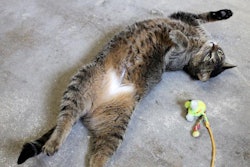
Dogs and cats use sensations, such as appetizing smells, to build their mental understanding of the world and form memories, and that holds true for pet food, said Temple Grandin, author and professor of animal science at Colorado State University, who delivered the closing presentation at Petfood Forum 2017.
“They like variety,” Grandin told Petfood Industry. She confirmed that the smells and textures of a new food can help fulfill the animals’ mental need for novel experiences.
Senses preeminent in pets’ perceptions
Animal minds are sensory-based, not word-based like many humans, Grandin emphasized.
“Smell is a dog’s social life,” she said. “Vision is the sense to avoid things that are dangerous.”
Grandin offered advice for introducing new pet foods. In her work with pigs, cows and horses, she’s discovered key principles of animal behavior. Her observations have revolutionized livestock handling practices on farms and abattoirs. However, conventional wisdom holds true when introducing cats and dogs to unfamiliar diets, including therapeutic pet foods, she said.
“Just gradually switch it over,” she explained. “Just mix a little in and gradually switch it over.”
The key is to not traumatize the animal when introducing something new, she said. Let the animals explore the new item at their own pace, and avoid startling them while they explore.
Pet food sensory analysis benefits
Grandin emphasized the preeminence of imagery and sensations in dogs and cat minds. Pet food companies can glimpse what those pets may be experiencing using techniques developed by another Petfood Forum speaker.
During her keynote address at the Petfood Innovation Workshop, Kadri Koppel, PhD, assistant professor at Kansas State University, explained how pet food sensory analysis can give clues about which products will please both pets and their owners.
“Consider sensory testing as one of the ways to figure out what pets and owners really like,” she told Petfood Industry. “I think that will help you along in your market success and your product success.”
Published research on pet food sensory analysis
Not all pet food companies have access to sensory analysis laboratories to determine the characteristics of their products. Those pet food companies can learn from published research and conduct their own in-house sensory analysis, Koppel said.
For example, Koppel’s paper “An initial lexicon for sensory properties of dry dog food,” published in the Journal of Sensory Studies, defined sensory characteristics of pet food, such as barnyard, brothy, brown, grain, soy, vitamin, off-flavors, oxidized oil, cardboard and stale.
Once those characteristics have been determined in a pet food, the results can help pet food companies understand what attributes influence pet preferences for one food or another.

















